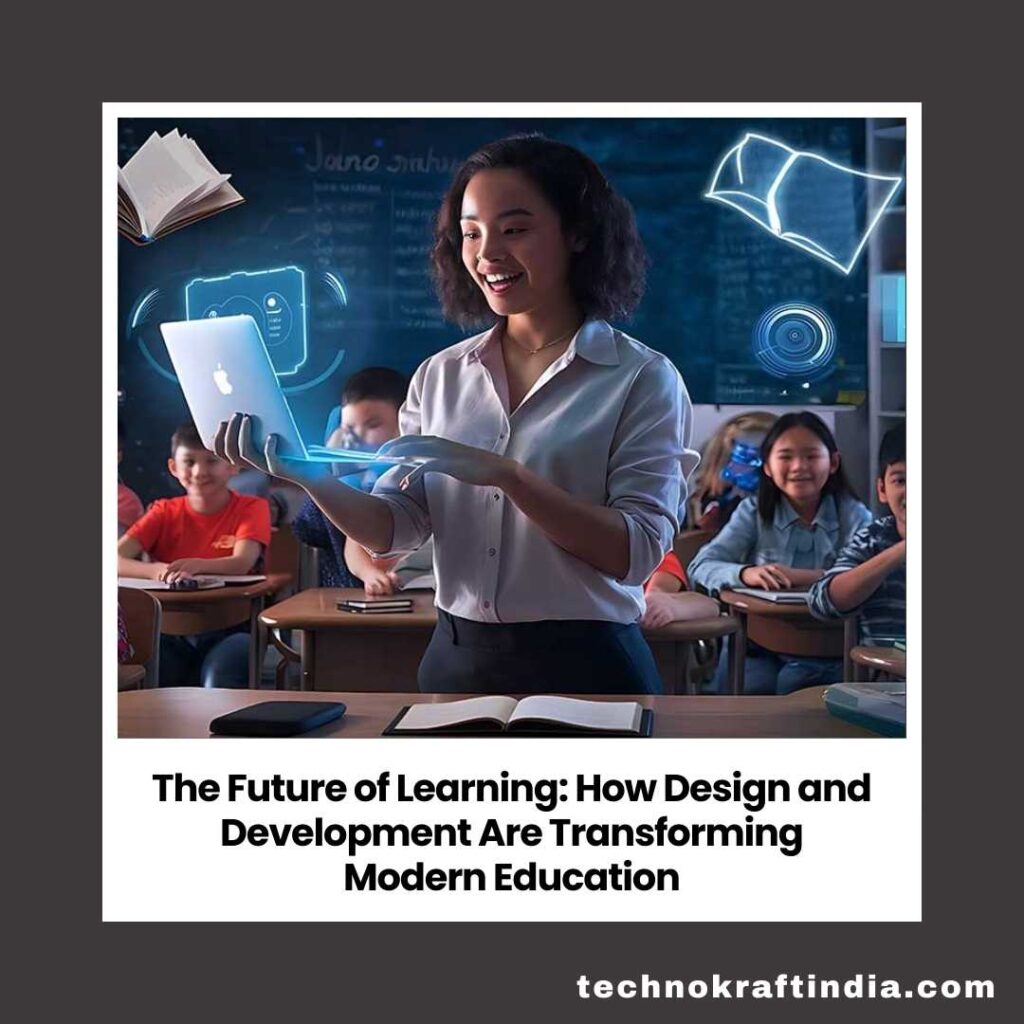
The Future of Learning: How Design and Development Are Transforming Modern Education
The Future of Learning: How Design and Development Are Transforming Modern Education
Education is evolving at a pace no one imagined even a decade ago. As digital transformation reshapes every industry, the way people learn, upskill, and solve problems has changed forever. This is where Modern Learning Design Development plays a pivotal role. It combines creativity, psychology, technology, and strategy to create powerful learning experiences that enhance performance, improve engagement, and deliver measurable results. Today, organisations and educators depend on structured learning ecosystems that align with real-world needs. Because of this, learning designers and developers have become essential in shaping how learners think, grow, and adapt in a fast-moving world.

In this blog, we explore how learning design and development influences modern education, why it matters more than ever, and how it helps create content that is purposeful, engaging, and impactful. With well-defined strategies and thoughtful execution, it transforms learning into a dynamic journey rather than a simple transfer of information.
1. The Strategic Foundation of Learning Design and Development
Modern Learning Design Development starts with understanding what learners need and how they absorb information. It is not just about creating materials. It is about creating meaningful learning experiences. Designers analyze the target audience, their challenges, and expected outcomes. This ensures learning aligns with real needs. The field blends instructional theories, modern technology, and user-centric planning. As a result, learning becomes structured, clear, and goal-oriented.
A strategic learning design process begins with a strong framework. The most common models include ADDIE, SAM, and Bloom’s Taxonomy. These models help professionals map content effectively and create seamless learning journeys. They guide how information should flow, how learners should interact with material, and what results must be achieved. This clarity supports trainers, teachers, and organizations in setting well-defined expectations.
Moreover, learning design and development focuses heavily on relevance. Learners stay motivated when content matches their real situations. Hence, designers incorporate role-based scenarios, problem-solving tasks, and relatable examples. These elements help the content become meaningful and memorable. With the right mix of structure and creativity, learning designers build solutions that meet both organizational goals and learner needs.
2. Crafting High-Impact Learning Experiences Through Engaging Content
Engagement is the heart of effective learning. If content does not capture attention, learners lose interest quickly. Learning design and development tackles this challenge by blending visual design, storytelling, and interactivity. Designers use multimedia elements like infographics, videos, simulations, animations, and quizzes to improve comprehension. These tools reinforce concepts and make learning enjoyable.
Clear and concise writing improves communication. Learners understand topics faster when sentences are simple and direct. Designers focus on microlearning, breaking large topics into smaller, digestible modules. This approach reduces cognitive overload and helps learners absorb information at a steady pace. It also supports flexible learning, making it easier for people to learn at their convenience.
Gamification is another powerful technique. When learners receive points, badges, scores, or leaderboards, they engage more deeply. It gives them a sense of progress and achievement. Additionally, scenario-based learning and case studies build real-world understanding. These methods help learners apply knowledge practically. With every interactive element added, the learning experience becomes more dynamic and effective.
Ultimately, thoughtful content design ensures that learning is not just consumed but experienced. It allows individuals to explore, reflect, and apply concepts with confidence.
3. Technology as the Driving Force Behind Modern Learning Solutions
Technology plays an extraordinary role in transforming how learning is designed and delivered. Today’s learners expect fast, flexible, and interactive experiences. Learning design and development incorporates a wide range of digital tools to meet these expectations. Learning Management Systems (LMS), virtual classrooms, AI-driven recommendations, mobile learning platforms, and interactive authoring tools have reshaped the learning landscape.
One of the biggest advantages of technology is access. Learners can now study from any location and on any device. Mobile learning has become a core part of modern training programs. It supports microlearning modules, quick assessments, and just-in-time resources that benefit busy learners. Developers optimize modules for smartphones and tablets to ensure seamless performance.
Artificial Intelligence adds an entirely new dimension to personalized learning. AI can track learner behavior, identify learning gaps, and recommend customized content. This ensures individuals get the right training at the right time. Chatbots, virtual tutors, and automated feedback systems guide learners throughout their journey. These tools increase efficiency and reduce the need for constant manual support.
Virtual Reality (VR) and Augmented Reality (AR) offer immersive learning experiences. They create realistic environments where learners can practice skills safely. For industries like healthcare, aviation, and engineering, this is extremely valuable. Simulated environments reduce risks and allow learners to gain confidence before performing tasks in the real world.
Through technology, learning design and development continues to push boundaries and redefine what modern learning can achieve.
4. Measuring the Impact: Evaluation, Analytics, and Continuous Improvement
Creating a learning program is only the first step. Measuring its impact is critical. Learning design and development integrates evaluation strategies to track effectiveness. Designers use models such as Kirkpatrick’s Evaluation Framework to assess performance and engagement. This helps determine whether learning has achieved its goals.
Analytics play a vital role in this process. Through LMS data, quiz scores, participation rates, and feedback forms, designers gain insights into learner behavior. These insights help them refine and improve the program. For example, if learners struggle with a module, designers can adjust the content or provide additional support materials.
Continuous improvement ensures learning remains relevant. Industries change quickly, and training programs must evolve with them. Designers regularly update course materials to reflect new trends, tools, and best practices. This keeps learning fresh and aligned with industry demands.
Another essential part of evaluation is learner feedback. When learners share their experiences, designers understand what works and what does not. This direct input provides valuable direction for future improvements. It also strengthens trust between learners and learning providers.
Through consistent evaluation and data-driven decisions, learning design and development creates programs that deliver lasting impact and long-term growth.
5. The Growing Importance of Learning Design and Development in the Future
The demand for effective learning strategies continues to grow. Organizations want employees who can adapt, innovate, and solve complex problems. Learning design and development helps build these skills. It supports continuous learning cultures that encourage creativity and critical thinking.
Hybrid learning models are now the norm. A blend of online and offline learning ensures flexibility and deeper engagement. Designers create ecosystems that work across multiple formats. These ecosystems ensure learning is accessible, structured, and consistent.
Workforce transformation is another driving force. As industries evolve, employees need new skills. Learning programs help close these skill gaps. They support reskilling and upskilling initiatives that keep people competitive in a dynamic job market.
Personalization will shape the future of learning. Learners want content tailored to their pace, goals, and environment. Learning design and development will continue to integrate advanced tools that support personalized experiences. Adaptive learning systems, AI recommendations, and smart content delivery will make learning more efficient than ever.
The field will also expand into emerging domains such as sustainability training, emotional intelligence development, and digital wellness. These areas will play a major role in shaping future workplaces. With strategic planning and innovative solutions, learning design experts will be at the center of this transformation.
Conclusion
Modern Learning Design Development has become a powerful force in shaping the future of education and professional growth. It blends creativity, structure, and technology to build meaningful learning experiences. By understanding learners, crafting engaging content, leveraging innovative tools, and measuring results, learning professionals deliver solutions that matter. The field will continue evolving as new technologies emerge and learning needs change. With thoughtful design and strong development strategies, learning can remain impactful, relevant, and transformative. In a world that thrives on knowledge and growth, learning design and development will always stand as a guiding light for progress.
